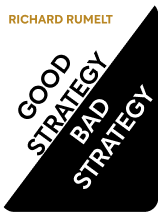

This article is an excerpt from the Shortform book guide to "Good Strategy Bad Strategy" by Richard Rumelt. Shortform has the world's best summaries and analyses of books you should be reading.
Like this article? Sign up for a free trial here .
Do you want to learn how to develop a business strategy? What factors should you take into account when designing a big-picture strategy for your business?
According to Richard P. Rumelt, the author of Good Strategy, Bad Strategy, your business strategy must be designed in such a way so as to capitalize on the key strengths of your organization. Once you’ve identified your strengths, figure out how you can them to increase your competitive advantages. You can do this by leveraging your strengths onto one pivot point, and by pressing your advantages by increasing them, broadening their influence, or increasing demand for them.
In this article, we’ll discuss his advice on how to develop a business strategy for your organization.
How to Develop a Strategy That’s Geared for Success
In his book Good Strategy, Bad Strategy, Richard Rumelt shares his expert advice on how to develop a business strategy that’s geared for success. He reinforces that a good strategy is one that leverages your strengths and focuses on one specific and narrowly defined goal. In the same way that a lever focuses force onto a single, pivotal point, a good strategy focuses mental energy, resources, and actions onto one crucial objective that causes other objectives to fall into line. In the same way that knocking loose one particular keystone can cause a giant arch to fall, leverage applies pressure to one specific area that will have an outsized effect on other areas.
Finding that pivotal area is the trick to forming a good strategy.
A real-life example of this is when Bill Gates developed an operating system for IBM in 1980 but negotiated the rights to sell the software to third parties afterward. This aspect of his contract gave him leverage he used to propel Microsoft to success.
Strategic leverage comes from three insights:
- Predictions point you in the right direction.
- Pivot points center your leverage.
- A concentration of efforts magnifies their effects.
1. Predictions Point You in the Right Direction
Finding leverage—in other words, the place where you should focus all your efforts—starts with figuring out what’s likely to happen in the future. This means predicting the behaviors of your customers or your rivals in response to events, taking into consideration their habits, preferences, and policies, and directing your efforts accordingly. For corporate strategy, this often means predicting consumer buying habits and the resulting competitor reactions.
An excellent example of successful corporate prediction is Toyota’s billion-dollar investment in the development of hybrid gas-electric engines. Their strategy was prompted by two predictions: First, rising fuel prices would eventually spark consumer demand for hybrid vehicles (consumer buying habits), and second, to respond to this rising demand, rival carmakers would prefer to license Toyota’s technology rather than develop their own (competitor reactions).
For governmental strategy, this means predicting, for example, what a rival military will do. We’ve already discussed a successful military venture, in Desert Storm, where Schwartkopf correctly predicted the movements of the Iraqi army; an example of an unsuccessful governmental prediction is the later experiences of the U.S. military in Iraq after the overthrow of Saddam Hussein, when they failed to anticipate the vigorous insurgency that arose.
2. Pivot Points Center Leverage
A good strategy can only harness leverage if it can identify the pivot points where it should apply force. Pivot points are opportunities where focused energy will be magnified. They are usually imbalances in a situation—in other words, an area where one rival has an outsized advantage over another in capability, resources, or insight.
7-Eleven’s Japanese arm provides a great example of how to properly leverage pivot points. The company found that consumers had tastes that varied widely from region to region and that customers loved newness and variety. To take advantage of those specific aspects of their consumer market, they developed strategies to offer dozens of soft drink flavor options in each store and to change out many of the flavors each week: pivot points that set them apart from their competition.
3. A Concentration of Efforts Magnifies Their Effects
A good strategy then coordinates an organization’s efforts in order to concentrate them on those pivot points.
There are three reasons to concentrate your organization’s efforts. First, you have limited resources—money, products, time, and mental energy—and coordinating them towards one goal will have a more significant effect than spreading them thinly.
Second, a concentration of many efforts into one area can have a much larger impact than the impact of many efforts focused on different areas: In other words, the sum impact will be greater than its parts. This is called the “threshold effect.” It means that sometimes, your efforts will produce no results until they exceed a particular threshold, but once you pass that threshold, your efforts will produce benefits. Therefore, you should focus lots of effort on one area, to ensure you pass that area’s “threshold” and start reaping benefits, rather than focusing minimal effort on lots of areas, and never passing any thresholds.
The advertising industry is an example of a field highly influenced by the threshold effect. A company spending a small amount on advertising will typically see no benefit. It has to spend a lot on advertising to start earning the public recognition that will bring it benefits from an ad campaign—new customers, for example. For this reason, many companies adopt action plans in which they concentrate their ad efforts; for example, they’ll saturate the airwaves over short periods of time rather than space their ads out more evenly. Outside of advertising, companies often effectively concentrate efforts when they seek out customers in a small, targeted market segment rather than seeking out the same number of customers spread over a larger market.
Third, from a psychological perspective, it feels better to the people tasked with solving problems—and looks better to outsiders observing—to see one project completed very well rather than several projects completed somewhat well. This perception can bring additional benefits: By coming across as very successful, even in a smaller area, people assume you can be successful in larger areas and will more readily give you the opportunity to try—they might invest in your project or allow you to expand its scope. For example, vastly improving two schools in a region can have a stronger impact on public opinion than improving two hundred schools in that region but by only three percent each. This gives the improvement program a boost, and it’s more likely to be used for additional schools.
Press Your Advantages
Ultimately, a good strategy identifies where your strengths—your advantages—can be applied to your opponent’s weaknesses.
Competitive advantages are born of asymmetries: differences between rivals, meaning one company does something better than the other. A leader’s job is to identify which of these asymmetries are critical. Then, a leader must press these critical strengths while remaining aware of her rival’s critical strengths so that she can sidestep them.
Problems arise when leaders respond defensively to their competitor’s strengths rather than offensively to their competitor’s weaknesses. For example, after 9/11, the U.S. got drawn into a protracted simmering conflict that played to its opponent’s (the Taliban’s) strengths: patience, and less political sensitivity to ongoing casualties. It was unable to capitalize on its own strengths—its superior military capabilities—because it allowed its opposition to set the terms of the engagement: that the side with the least sensitivity to casualties can outlast the other.
Develop a Sustained Competitive Advantage
Long-term success relies on having a sustained competitive advantage. This phrase has two parts: competitive and sustained. As discussed above, an advantage is competitive when you do something better than your rivals. An advantage is sustained when your competitors cannot replicate it. This usually occurs because they cannot replicate the resources underpinning it. So for example, a solid patent, a long-standing reputation for quality, or an outsized economy of scale will all give a company an advantage that is hard for a rival to overcome.
Sustaining your competitive advantage often means adjusting it or finding new ways to apply it as your industry evolves. A competitive advantage is only financially valuable if a leader can figure out how to increase its value against changing market conditions. A company with a competitive advantage that doesn’t change with the changing business landscape might end up trundling along slightly profitable but never realizing the full potential of its competitive edge.
For example, eBay has a competitive advantage as a platform providing the most efficient way to buy or sell a personal item online, and it has a broad customer base, a state-of-the-art payment system, and a rating system that sets it apart from competitors. However, its market value has steadily declined for many years. The company must figure out a way to harness and leverage its competitive advantage in order to create financial value from it.
There are four ways a company can try to press its competitive advantage in response to changing conditions. It can:
- Increase its advantage.
- Broaden its advantage.
- Increase demand for its advantage.
- Limit its rivals’ ability to replicate its advantage.
Each of these approaches is explored in the sections below.
Increase Your Advantage
One way to define an advantage is the difference between what it costs you to produce a product or provide a service and how much a customer values that product or service. Increasing an advantage means either reducing its costs or increasing its value to customers, or both. To reduce costs, examine every aspect of how your operations work and reevaluate processes you might be taking for granted. To increase customer value, study your customers and develop empathy for them that allows you to understand their attitudes, values, and desires.
An example of finding novel ways to decrease costs through keen observation is when Frank Gilbreth revolutionized the process of bricklaying in the early 1900s. Bricklayers had, for centuries, worked in the same way, but Gilbreth carefully studied the process and realized he could more than double productivity by simply adjusting some of the procedures: placing brick pallets closer to chest-height and improving mortar consistency. In doing so, he decreased his production costs (the time needed to lay bricks) and accordingly, his competitive advantage increased.
Broaden Your Advantage
Broadening an advantage means applying it to new fields and new competitors. To successfully do this you must focus on what skills and resources underpin a particular advantage, instead of the specific products, buyers, and competitors that are linked to it.
It’s important to focus on skills and resources because if a company thinks of itself in terms of a product instead of in terms of the skills it uses to bring that product to market, it might expand into fields it knows nothing about because the skills required for success are different. For example, in the above case study of Crown Cork & Seal, when they eventually expanded into plastics, they did so because they pinned their advantage as a producer of containers rather than their true advantage as a producer of high-end, tailored production runs.
An example of a company effectively broadening its advantage is DuPont, which started as an explosives company and leveraged its expertise in chemistry (its skill set) to ultimately manufacture plastics and other synthetics for household consumer use. Instead of simply chasing the explosives industry, they looked at what other uses they could put their skills to.
Increase Demand for Your Advantage
Another way you can press your advantage is to increase demand for your product or service. There are two ways to increase demand: either increase the number of buyers or increase the amount each buyer demands. Then, you must be sure that you are positioned to take advantage of this new demand in a way that your competitors are not.
An excellent example of this process comes from the previously mentioned Roll International. In addition to nuts and citrus, the company also invested in pomegranate orchards and created the POM Wonderful company. When it planted its orchards, pomegranates were a somewhat exotic fruit with a small market. In fact, Roll’s investment alone increased U.S. production of pomegranates sixfold. However, the company saw potential where no one else had, and it implemented an aggressive marketing campaign to educate consumers on the health benefits of pomegranate juice. By the time the crop was ready for market, the company had created a new beverage category to receive it.
Limit Rivals’ Ability to Replicate Your Advantage
One more way you can press your advantage is to limit your competition’s ability to replicate it. Companies do this all the time when they extend patents and defend trademarks, leveraging legal protections to limit competition.
Companies also do this by constantly innovating, making their products or services into moving targets that are difficult for competitors to duplicate before they’ve improved again. For example, Microsoft is constantly upgrading and evolving its Windows operating system, consistently raising the bar for any potential imitators.

———End of Preview———
Like what you just read? Read the rest of the world's best book summary and analysis of Richard Rumelt's "Good Strategy Bad Strategy" at Shortform .
Here's what you'll find in our full Good Strategy Bad Strategy summary :
- The essential components of good strategy and the faulty thinking behind bad strategy
- Specific and measurable techniques for designing a focused strategy for success
- How to overcome challenges and gain a competitive edge






